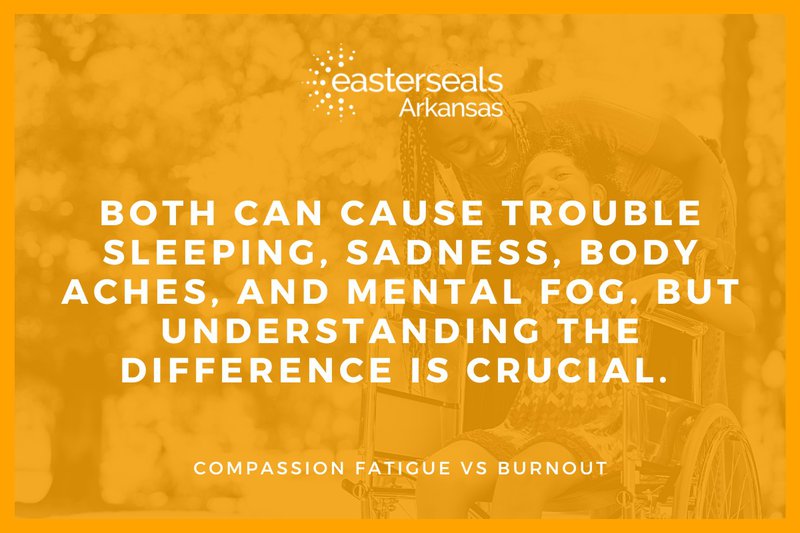
If you care for someone with disabilities, you’ve likely felt drained or empty. That may be burnout, or it could be something deeper called compassion fatigue. They may initially feel the same, but they are not; the way they affect you as a caregiver differs. Understanding the differences in compassion fatigue vs burnout helps you stay strong, focused, and well. How do you overcome compassion fatigue or burnout? Support and resources for caregivers are available now and can help you move forward. You don’t have to do it alone.
Key Takeaways:
- Compassion fatigue is caused by exposure to others' trauma; burnout stems from constant workplace stress.
- Compassion fatigue leads to emotional numbness; burnout results in loss of motivation or energy toward work.
- Common symptoms: sadness, guilt, withdrawal, headaches, sleep issues, and brain fog.
- Compassion fatigue can strike suddenly; burnout builds gradually.
- Both can appear together and affect job performance, motivation, and safety.
- High-risk groups: nurses, therapists, caregivers.
- Key prevention strategies: firm boundaries, staff wellness plans, and thoughtful leadership.
- Recommended resources: Easterseals Arkansas and caregiver support groups.
Understanding Compassion Fatigue vs Burnout
The main difference between compassion fatigue and burnout is where it stems from. Compassion fatigue stems from helping others in distress, and burnout stems from prolonged work-related pressure.
Compassion fatigue, often called secondary trauma, happens when someone absorbs others’ pain. This is common in roles with high emotional demands. Nurses, therapists, and caregivers may feel emotionally numb or disconnected, even while intending to help.
Burnout develops differently. It grows from relentless stress. People feel exhausted. They may become frustrated with their duties and lose the sense of purpose in their role. Burnout often results from work-related overload.
At first, the symptoms may overlap. Both can cause trouble sleeping, sadness, body aches, and mental fog. But understanding the difference is crucial. Compassion fatigue impacts emotional connection to people, while burnout impacts how someone feels about their work. One blunts empathy; the other dulls motivation.
How Compassion Fatigue and Burnout Overlap
Both conditions can happen at the same time, or as a result of one another. Compassion fatigue can lead to burnout. A caregiver who feels numb from trauma may also feel overwhelmed by duties. When both occur, the person may feel hopeless, remain stuck in a state of hyper-awareness, and even consider quitting.
However, they unfold differently. Compassion fatigue can happen quickly, but may ease with time away or rest. Burnout builds slowly and often deepens over time; it may require more significant life or job changes.
To reduce both, keep boundaries clear, seek rest, talk with colleagues, and get trusted guidance. Whether you feel worn down by stress or disconnected from care, early action helps.
Common Signs of Compassion Fatigue and Burnout
The first signs of both can be easy to ignore. A person may feel tired, low, or unmotivated without knowing what's wrong. These feelings may seem normal, but tend to grow.
What emotional and behavioral indicators appear early in both?
- Sadness, irritability, guilt, numbness, and withdrawal show up early in both.
These behaviors often appear when someone gives care without breaks. Small irritations may trigger outbursts. They may stop enjoying daily moments or ignore friends. It can feel like caring is too much, even when their heart still wants to help. A common early signal: snapping at coworkers or family for no clear reason. This may not be simple anger, but unspoken stress showing itself.
How do physical signs of compassion fatigue compare to burnout?
- Both can cause body aches, trouble sleeping, fatigue, and stomach issues.
With compassion fatigue, the body reacts to repeated stress from others’ pain. A person may feel dizzy, cry frequently, or struggle to eat or rest. Some may also experience chest pain or a racing heart, even panic attacks. Burnout causes many of the same issues. But it tends to develop gradually. People may wake up tired every day, feel physically heavy, and lose focus. Illness can happen more often.
Compassionate Fatigue vs. Burnout: Learning The Difference
This is the clearest marker: if someone who once deeply cared grows emotionally flat, it's likely compassion fatigue. Signs include avoiding eye contact, missing phone calls, or saying, “I just don’t feel anything.”
Burnout shows up through detachment from tasks. They might say, “I couldn’t care less about this job.” The feelings shift about the work, not necessarily the people.
Compassion fatigue dulls empathy. Burnout erodes drive. Some experience both. A nurse may stop feeling connected to patients (compassion fatigue) and also feel their job has lost all meaning (burnout). Noticing these signs early avoids deeper pain.
Causes of Compassion Fatigue and Burnout
Common causes of compassion fatigue and burnout related to caregiving include:
- Long Hours
- Lack of Sleep
- High Stress
Caregivers often work through loss, pain, and emergencies. Some care for terminally ill people. This work can drain energy and emotion, especially without helpful systems at work or home. When someone gives without pause, emotional strain builds until they reach a breaking point.
How Trauma Affects Compassion Fatigue vs Burnout
Trauma exposure adds mental stress by absorbing others’ suffering.
Doctors, nurses, and therapists often witness deep pain. Every moment of despair or loss makes an impact. Over time, they may experience “secondary trauma.” A healthcare worker may not be injured but feels connected to the wound. This builds until they react emotionally, even outside work. They might lose hope or struggle with meaning. The more intense the stories, the heavier they feel.
This is how compassion fatigue grows. While burnout builds over time, compassion fatigue comes from trauma. The helper starts to feel trapped in someone else's sorrow. Mental health experts say the risk rises when trauma is regular and strong. Without a way to pause or recover, the pain lingers.
Prevention Strategies To Reduce Risk
Set limits. Saying “no” matters. Breaks during the day help reset. Time outside or a personal hobby helps calm the brain. Eat foods that nourish. Sleep well. Move in ways that feel good. Pay attention to your own emotional signals, just like you do for others.
Resources For Caregivers
Easterseals Arkansas offers support for caregivers by providing employment through our Community and Employment Services Waiver department, and through trusted experts in our programs. Working alone breeds fatigue. A trusted friend, a work buddy, or a peer group helps carry the load. Speaking out isn't a weakness; it’s a way to stay mentally strong.

Frequently Asked Questions: The Impact of Compassion Fatigue vs Burnout
Burnout and compassion fatigue affect how people work and live. They challenge both the body and mind, and the impact doesn’t stop when the workday ends.
How do they affect productivity and energy on the job?
The answer is clear: both reduce focus, energy, and care. Tasks drag. Errors increase. Workers lose pride in their efforts. They may stop trying because nothing seems to help.
Take nursing: an exhausted nurse might make mistakes or act coldly. The mind fogs, and decisions feel harder. Stress builds further after poor performance.
What are the job risks faced by caregivers?
Nurses and therapists may reach a point where staying is no longer possible. Turnover rises in these fields. Many leave due to unresolved pressure.
Job burnout links to mistakes that can harm clients. A tired therapist might miss warning signs. Compassion fatigue may also dull judgment. The impact is serious and wide.
What can untreated compassion fatigue lead to?
When ignored, compassion fatigue changes how a caregiver thinks and reacts. Without empathy, a person may become harsh or careless. Steps may be skipped; safety lapses may occur.
They might no longer feel guilt over their actions. This poses risks to both them and those who count on their care. Neither burnout nor compassion fatigue is a passing feeling. They are serious health threats. Recovery needs awareness, support, and steady steps.
When should someone seek support?
If someone feels joyless, numb, often upset, or ashamed of how they act, it’s time. If they want to help but feel they can’t anymore, it’s time. Getting help means strength. Helpers need support, too. And it’s available.
Support at Easterseals Arkansas
Burnout and compassion fatigue are different, but both are serious. We’ve covered what separates them, how they show up, and ways to stop them early. If these signs sound familiar, now is a good time to check in. Help is there. Take action early. Your well-being matters, and the care you give depends on it.
